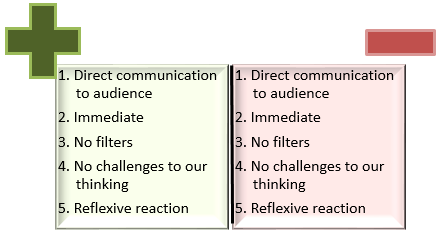 Any executive coach, management consultant, therapist, advisor, or good friend would tell a leader that it is not a good idea to implode on a small stage, let alone on the world stage. If a leader is well-known internationally, and TWEETING, we are talking about the world stage.
Any executive coach, management consultant, therapist, advisor, or good friend would tell a leader that it is not a good idea to implode on a small stage, let alone on the world stage. If a leader is well-known internationally, and TWEETING, we are talking about the world stage.
Apparently, Elon Musk’s ego was shattered when his offer to help rescue the Thai sports team in the cave was rejected as untenable. His reaction was to lob an insult via Twitter at a person involved in that rescue. Think of the example this leader is setting for those in his organization. Think of the reaction of his board, the stock market, and the SEC.
Then a few weeks later, there was the infamous tweet about taking Tesla private. From The New York Times August 15, 2018:
“…Mr. Musk’s tweet last week — expressing his intent to take Tesla private and declaring that he had “funding secured” for the multibillion-dollar transaction — was so impulsive, potentially inaccurate, poorly worded and thought out, and with such potentially dire consequences for himself, Tesla and its shareholders, that the board now must ask a sensitive but vital question: What was Mr. Musk’s state of mind when he wrote it?”
We wonder the same thing. See this month’s Executive Vitality article – Is Tweeting Healthy?
So we asked ourselves, is tweading[1] a good idea? Maybe. Let’s examine the pros and cons:
Let’s look at each one of these. Our communication style affects the health of our professional relationships and the health of our organizations.
- Direct communication to your audience. That is usually a very good idea. People need to see, hear from, and believe their leader. This mode of communication (direct), should build trust in an organization…if it is carried out in person. See Forbes: 10 Communication Secrets of Great Leaders (links provided at the end of the article).
- Immediate. Certainly, there are times when an immediate reaction is called for. For example, leaders must be ready to lead in times of crisis. See INSEAD: The Best CEOs Are Ready for Crises. However, an immediate response can lead to negative consequences; the old adage about counting to 10 (seconds, minutes, days) is often good advice.
- A person with no filters “… says exactly what is on his/her mind without cleaning up their language, no matter how offensive or politically incorrect it may be” (Urban Dictionary). In fact, it is a very good idea to clean up our language and choose our words carefully. Leaders’ listeners hear every word we say and will take those words very seriously. Of course, we do not want to be offensive—not if we want to create followership, loyalty, trust, openness, innovation, relationships, and collaboration. As to “politically incorrect” – political correctness has gotten a bad rap of late. Think of it as civility, respect, human dignity, fairness, objectivity, and humility.
- No challenges to our thinking. In our executive coaching practice, one of the top frustrations we hear from executives is that their leaders do not take input from their subject matter experts (SMEs). No one person has all of the information all of the time. This is why we have leadership teams and also organizations; otherwise, we would just have solo acts. Leaders need to seek diversity of input. When the stakes are high (as in leadership at most times), we need to get it right and that very likely will require input from our SMEs.
- Reflexive reaction. How often do we speak or act reflexively and then regret it? It happens. Speaking and acting reflectively is no doubt going to lead to better outcomes and relationships.
We are suggesting that thoughtful, mindful communication that is open, two-way (multi-way, actually), and builds trust is not only healthy for an organization but also for the leader personally and all individuals the leader affects inside and outside the organization. Intelligent, coherent communication will trump tweeting every time.
Do leaders in your organization communicate in a way that strengthens or undermines the health of the organization and those in it? How can you help builds leaders who communicate in a thoughtful and emotionally intelligent way?
Citations:
- https://www.nytimes.com/2018/08/15/business/elon-musk-tesla-board.html
- https://www.forbes.com/sites/mikemyatt/2012/04/04/10-communication-secrets-of-great-leaders/#42d0d45c22fe
- https://knowledge.insead.edu/leadership-organisations/the-best-ceos-are-ready-for-crises-9241
Footnotes
[1] Tweading definition: Tweeting while leading. (Source: coined for this article.)









